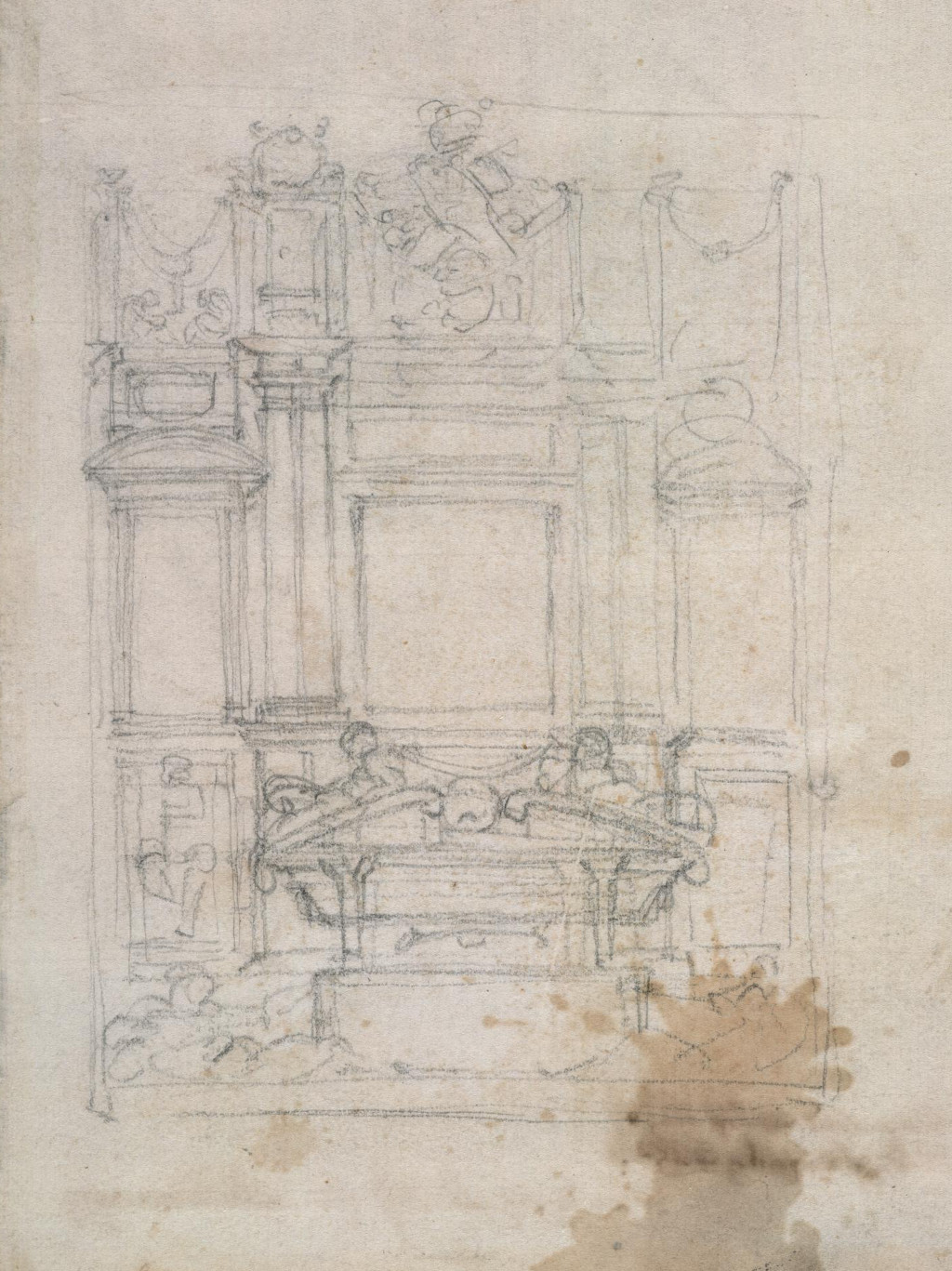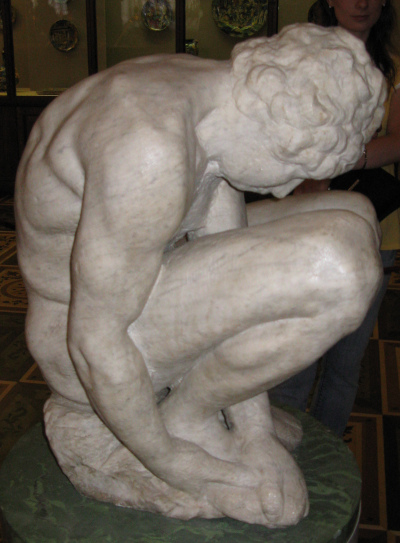Crouching Boy is a marble sculpture by Michelangelo which dates to around c. 1530 - 1534. It was intended to be a supporting piece within the tomb of the Medici family (specifically, alongside Lorenzo de' Medici) but today resides in the Hermitage Museum in St Petersburg, Russia.
Introduction
The crouched posture of the young boy in this sculpture ensures that the piece is only around half a metre in height, making it relatively short by Michelangelo's normal standards. When designing elements for a tomb, however, he would not want his sculptures to be fighting for attention, and so it made sense to produce a hierarchy of size, leading up to the more significant pieces.
Michelangelo's Crouching Boy is not considered to be one of his most famous sculptures. Its incomplete nature and relatively small size has caused most scholars to look elsewhere within the sculptor's career, but there is still plenty of artistic merit within this piece. All of the main features, for example, are present and identifiable. The posture is unusual too, within Michelangelo's oeuvre, bringing something different to his work within the discipline of sculpture.
This article aims to provide as much information on Michelangelo's Crouching Boy as is currently available, as well as placing it within the context of his overall career. It arrived at a time, in the 1530s, that Michelangelo was peaking as a sculptor, and continuing to pick and choose between high profile commissions as his reputation across Italy soared. He remains one of the world's most loved and researched artists of all time.
Table of Contents
- Introduction
- Description
- Studies for the Tombs
- Attribution
- Provenance
- Plaster Cast at the V&A Museum, London
Description
Michelangelo's Crouching Boy features a young child with thick, curly hair leaning forward in a crouched position. His head is tucked in close to his legs, with his arms hanging down on either side. His bottom is slightly raised, suggesting he is sitting on a small ledge, and this allows Michelangelo to shift his weight and balance slightly forwards.
Elements of the original stone surface have been left beneath the boy, and whilst all of the detail is identifiable, Michelangelo did not complete the final stages in which these elements are given a greater clarity.
Typically, the sculptor was respected for the precision of his torsos, with either rib cages or abdominal muscles recreated to an extraordinary level of accuracy. The child's front is covered here, due to his posture, but this allows Michelangelo to concentrate on his back instead.
The most impressive details added by Michelangelo within this sculpture would be the accuracy of the transition up the boy's back, as well as the highly intricate work around his knees which are a particularly complex part of the body. The shoulders and arms are also impressive, but Michelangelo had already displayed his mastery with these parts of the anatomy in many previous works.
A closer look reveals that the hands have not been finished, and Michelangelo would often complete hands and feet last. We see instead just a suggestion of fingers, leaving a rough estimate for how the final touches might have looked.
Additionally, the smoothing of the boy's arms, upper body and legs has allowed some of the natural variations found in the marble to show through, although only a few photographs of the sculpture will indicate this. Michelangelo would take great care in selecting the blocks of marble he used for each sculpture, but there would still often be surprises lurking inside as he started to chisel away.
Studies for the Tombs
Initially, Michelangelo would have planned the overall displays of each tomb within the Medici Chapels. After that, he would consider each sculpture one at a time. Many of his sketches were later discovered elsewhere in the building in a secret room, one of which we have included below.
The image below, taken from a drawing owned by the British Museum (see credit at the bottom of the page), is a small detail from a tomb sketch made by Michelangelo. In the far top left corner, you will notice two crouching figures, which reveals where the Crouching Boy sculpture was intended to be displayed. We have also included the larger version of the image underneath.
 Michelangelo.jpg) Study for the Medici Tombs (Detail) by Michelangelo
Study for the Medici Tombs (Detail) by Michelangelo
 Study for the Medici Tombs by Michelangelo
Study for the Medici Tombs by Michelangelo
Attribution
There remains some debate over the true attribution of this sculpture. Most scholars have accepted it as being by Michelangelo, but some still have doubts. Some have researched the quality of the sculpture, and concluded that some parts may not resemble the high standards of Michelangelo. Others have also pointed to differences between this piece and the study drawings for the tomb (PP432, Frank Zöllner, Michelangelo. The Complete Works. Paintings, Sculptures, Architecture).
There are many possible explanations for these points, though, such as whether Michelangelo used a helper to carry out some of the more menial tasks, and also that it is hardly surprising that initial rough sketch designs for the tomb were not followed identically. Therefore, the majority of evidence would support the claim that this was indeed from Michelangelo's very hands, and corresponds sufficiently closely with his original study drawings.
Provenance
Having left the sculpture unfinished, it was not possible to place Michelangelo's Crouching Boy within the Medici tombs as originally designed by Michelangelo. It therefore remained within the Medici collection for a number of years. By the late 18th century it was identified in the collection of John Lyde Brown in Wimbledon, South West London. It then purchased by the Russian Tsar, and later the piece was moved to the Hermitage Collection, St Petersburg, in 1851. It remains there today.
Plaster Cast at the V&A Museum, London
A plaster cast exists from the original sculpture and is located in the the V&A Museum in London, UK. It is out on display in one of two sections of the museum which are devoted to casts of this type. Works by the likes of Donatello and Luca della Robbia are also featured here through these casts, and the plaster version of Michelangelo's Crouching Boy was produced in 1884. It remains in excellent condition.
Image Credit
The image credits for each of the two images added in this article are included below, along with links to the original pictures, and details on the licences under which they have been published. We greatily appreciate being able to use imagery in this manner, and urge you to use the links below to find more items from these respective sources.
Crouching Boy by Michelangelo Buonarroti at the Hermitage, 1530-1534; Yair Haklai, CC BY-SA 3.0, via Wikimedia Commons
6733001, 1859,0514.823, 1520-1521 by Michelangelo, a study for one of the Ducal wall-tombs.; British Museum, CC BY-NC-SA 4.0
Bibliography
- Images sourced from Wikimedia under a variety of Creative Commons licenses. Further details regarding the particular license used, the location of the original image on Wikimedia and the original author/user are provided on each specific page.
- Michelangelo, Gilles Néret
- Vasari's Lives of the Artists, Giorgio Vasari
- Michelangelo. The Complete Works. Paintings, Sculptures, Architecture, Frank Zöllner, Christof Thoenes
- Michelangelo and the Sistine Chapel, Andrew Graham-Dixon




